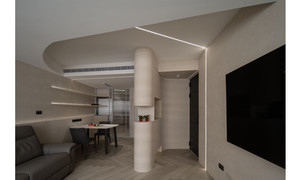Profound Contours
Designed by
WEI LUN HSU

Title:
Profound Contours
Category:
Interior Design Category
Location:
Taipei city, Taiwan
Designer:
WEI LUN HSU
Website:
Team:
JI SHOU WANG
Photo Credits:
WEI LUN HSU
Copyrights:
Due to the elongated layout of the interior, the design team decided to avoid unnecessary wall structures and contrasting flooring materials for spatial delineation. Rather, the team utilized variations in linear lighting to define the spatial vocabulary. The entire interior is planned with a simple and pure design approach, using soft colors and enlarging the visual depth to create a sense of wabi-sabi aesthetics.
The entire space was redesigned with zero corridors, allowing for more efficient utilization of limited space and creating a smoother delineation between zones. Simultaneously, the ceiling is designed with curved arcs to alleviate the imposing overhead beams. In the dining area, particular attention is given to using curved design elements, and aligning the dining table with the wall. Additionally, the angle of the entryway's sloping wall is considered to amplify the entrance, thereby imbuing the spatial domain with a sense of airiness.
In this design, artistic coatings are extensively employed on the spatial facade, using shades that evoke a “milk tea color” and textured sensation to establish an ambiance that exudes comfort and warmth. LED aluminum strip lights are integrated to expand the visual perspective of living spaces. The floor is laid out in an SPC herringbone pattern, cleverly utilizing directional guidance effects to visually enlarge the elongated layout.
The design team prioritized environmental sustainability and opted for materials such as formaldehyde-free artistic coatings and latex paints. They integrate recyclable and reusable elements like SPC flooring, green building materials like calcium silicate boards, and LVL panels. Unnecessary embellishments are discarded in the design, minimizing resource waste. LED aluminum strip lights are used for lighting, not only creating a spatial ambiance but also promoting energy efficiency and electricity conservation. Through concrete actions, they manifest their commitment to environmental care.









